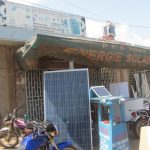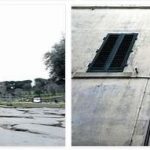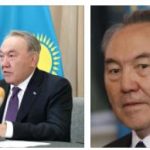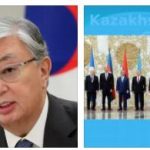Mining and industry
The share of industry in GDP is around 35%. The leading industries are mining, nuclear and chemical industries, mechanical engineering, construction and pharmaceuticals.
The largest mining and steel-producing companies are located in central Kazakhstan, where coal and ore deposits are located close together in Karagandy / Temirtau and Ekibastus (Pavlodar region). The most important producer is ArcelorMittal. With an output of almost 18,000 t, Kazatomprom is one of the largest uranium producers in the world, but at the end of 2017 it had to announce a significant reduction in production due to lower demand. Another, also internationally active mining company ENRC (Eurasian National Resources PLC) has been absorbed into the Eurasian Resources Group under somewhat dubious circumstances. Kazakhstan has major deposits of rare earths that are currently being increasingly marketed.
Recently, car production has been given future opportunities. In addition, individual companies in the light and food industry were able to hold their own in the market, for example the sweets manufacturer Rachat in Almaty.
Agriculture
The agricultural sector accounted for only 4.7% of GDP in 2017, but it is a not unimportant employer because around 18% of the working population are employed in agriculture. For the urgently needed modernization, the government has launched the agribusiness program, which is to run from 2013-2020. But experts also see potential for improvement beyond this.
Most of the agricultural land used (more than 20 million hectares) is still state-owned and leased on a long-term basis. Above all – in the north of the country – grain is produced, in the south fruit / fruits and in irrigated agriculture cotton. The production of sugar beet and tobacco is also important. The viticulture at the foothills of the Tien-Shan is (re) building still in a German wine critic but was already evident by the quality done.
Grain production is subject to extreme fluctuations due to the weather: 8.8 million t were brought in in 2010, a record harvest of 27 million t in 2011, and 19.7 million t in 2018. Kazakhstan exports a large part of this grain and is therefore dependent on world market prices.
The situation in animal husbandry is more problematic. Most of the animal production takes place in small farms. Even if the trend has been increasing in recent years, they cannot meet the demand for meat and milk; there is a high dependency on imports. Fresh milk is more expensive in Kazakhstan than in Germany. Camel milk is attracting interest in the German media, but it will remain a niche product. The situation with the breeding of Karakul sheep (wool) is assessed more positively, but here, too, the results of 1989 have not yet been achieved.
As in industry, Kazakhstan is also looking for ways to modernize and introduce new technologies in agriculture, also in cooperation with Germany. The OECD sees good approaches in agricultural policy, but calls for, among other things, a more sustainable use of natural resources and a strategy for long-term competitiveness.
Banks
According to ethnicityology, Kazakhstan has the most highly developed banking system in Central Asia. At its head is the National Bank, which implements the state’s monetary and credit policy, regulates and controls the currency and is responsible for banking supervision.
The real estate and financial crisis of 2008/09 plunged all banks in the country into a severe crisis. At that time, the state had to raise 10 billion US dollars from the Samruk-Kazyna fund to rescue = nationalize several banks. The process of coming to terms with the crisis continues to this day, banks are sold or merged. In 2016, 46 domestic and foreign financial institutions were operating in the country. The system is highly concentrated, with the five largest dominating the market. The largest private bank is Kazkommertsbank with a market share of 24%. Other commercial banks of importance are: Halyk Bank, Eurasian Bank, ATF and Bank Center Credit. At the end of 2013, after a long search, the sale of the last of the three banks affected by the crisis, the BTA, which had been the largest bank in the country until the financial crisis, was announced. However, this did not solve the problems in the banking sector. Again and again the National Bank had to intervene to rescue banks. After several financial institutions got into difficulties due to the high capital outflow abroad, this was limited in summer 2018.
The International Financial Center (AIFC) was opened in Astana on July 5, 2018, with the hope that Kazakhstan will become the leading regional financial center and at the same time one of the largest in Asia.
Foreign trade
Despite the efforts of the Kazakh government to diversify the economy and develop the manufacturing industry, raw materials exports still accounted for more than 3/4 of the country’s exports in 2016 (of which oil 52.7%). In contrast, mainly machines (2016: 17.1%), food (9.5%), electronics and electrical engineering (10.7) are imported. After years of growth, the value of exports has been falling for several years and in 2016 was due to the low oil prices at 36.8 billion US dollars (2011 it was more than 88 billion US dollars.) 2014 was the first time since 2009 a decline in Import figures recorded (up 15.6% to 41.2 billion US dollars), the trend continued in the following two years (2015: 30.6 billion US dollars; 2016: 25.2 billion US dollars -Dollar), 2017 and 2018 is again on an uptrend (29.6 and 33.7 billion.
As in previous years, Kazakhstan’s most important foreign trade partners were Italy (19.3% of total exports) in 2018, ahead of China (10.3%), the Netherlands (10.2%) and Russia (8.5%). In terms of imports, Russia was the leading nation (38.1% of total imports), followed by China (16.5%) and Germany (5.1%).
Kazakhstan is the most important partner of the German economy in Central Asia. In 2017, Germany exported products worth around 3.6 billion euros to Kazakhstan and imported goods worth around 1.3 billion euros. The German economy is represented in Kazakhstan with around 160 representative offices. The trend is increasing. Realizing the raw materials agreement signed when President Nazarbayev’s visit to Germany in February 2012 is obviously not as easy as hoped. Despite the economic crisis, trade relations between the two countries are considered good.









